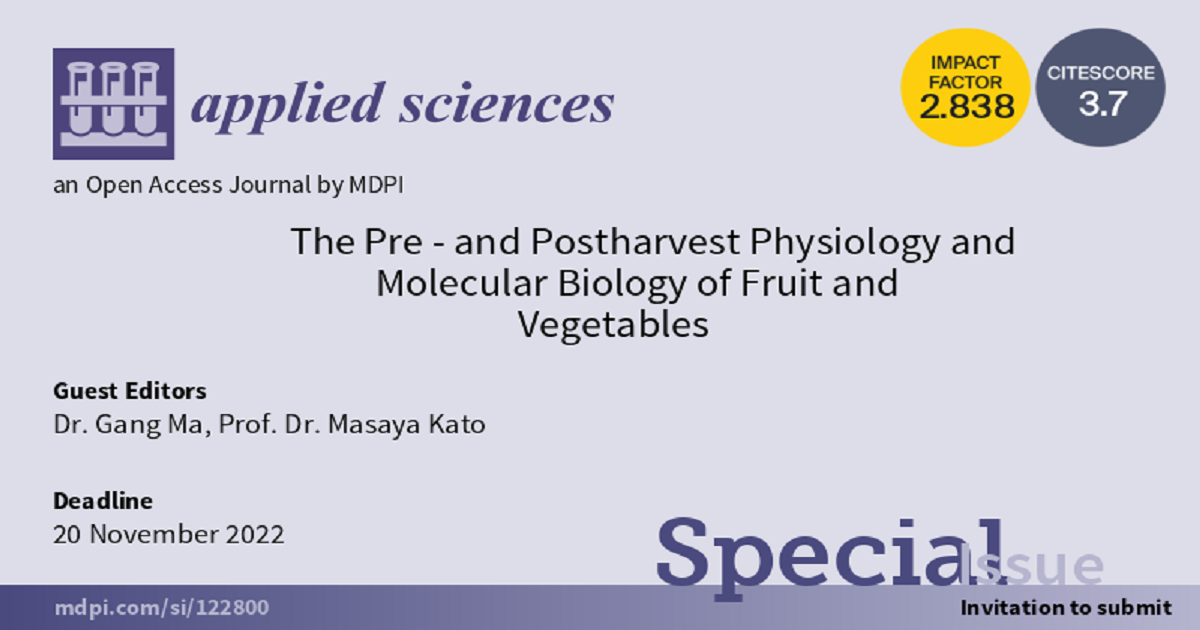The Pre- and Postharvest Physiology and Molecular Biology of Fruit and Vegetables
A special issue of Applied Sciences (ISSN 2076-3417). This special issue belongs to the section "Agricultural Science and Technology".
Deadline for manuscript submissions: closed (10 May 2023) | Viewed by 4986

Special Issue Editors
Interests: plant physiology; plant molecular biology; postharvest biotechnology; fruit and vegetables; carotenoid; ascorbate; flavonoid; LED light
Special Issues, Collections and Topics in MDPI journals
Interests: horticulture crops; plant secondary metabolites; plant physiology; plant biotechnology; abiotic stress; transcriptomics; food chemistry
Special Issues, Collections and Topics in MDPI journals
Special Issue Information
Dear Colleagues,
Fruit and vegetables, which represent an important part of our daily diet, are important sources of carbohydrates, proteins, organic acids, vitamins, and bioactive compounds. Consumption of fruit and vegetables not only provides basic nutrition for humans but also has potential health-promoting effects in reducing inflammation and preventing chronic diseases. Since fruit and vegetables are still alive after harvest, they are highly perishable products with an active metabolism subjected to several losses between harvest and consumption through microbial decay, physical injury, and senescence during postharvest life. To reduce losses and improve quality, handlers and producers need understand the biological, environmental, and technological factors affecting quality and deterioration. In recent years, various techniques for delaying postharvest senescence of fruit and vegetables have been investigated, such as modified atmosphere (MA) or controlled atmosphere (CA), different types of packaging, treatment with chemicals and plant hormones or their inhibitors, ethanol vapour treatment, and edible coatings. In this Special Issue, we aim to discuss the pre- and postharvest physiology, biological basis, and molecular mechanisms of ripening and senescence of fruit and vegetables. We warmly welcome submissions, including original papers and reviews, on (but not limited to) the following topics:
- Improvement of quality of fruit and vegetables after harvest
- New preservation and processing technologies for postharvest fruit and vegetables
- Biosynthesis of bioactive compounds in pre and postharvest fruit and vegetables
- The regulation mechanisms of physiological disorders occurring in postharvest fruit and vegetables
- Novel techniques controlling postharvest diseases in fruit and vegetables
- The molecular mechanisms of ripening and senescence in postharvest fruit and vegetables
Dr. Gang Ma
Prof. Dr. Masaya Kato
Guest Editors
Manuscript Submission Information
Manuscripts should be submitted online at www.mdpi.com by registering and logging in to this website. Once you are registered, click here to go to the submission form. Manuscripts can be submitted until the deadline. All submissions that pass pre-check are peer-reviewed. Accepted papers will be published continuously in the journal (as soon as accepted) and will be listed together on the special issue website. Research articles, review articles as well as short communications are invited. For planned papers, a title and short abstract (about 100 words) can be sent to the Editorial Office for announcement on this website.
Submitted manuscripts should not have been published previously, nor be under consideration for publication elsewhere (except conference proceedings papers). All manuscripts are thoroughly refereed through a single-blind peer-review process. A guide for authors and other relevant information for submission of manuscripts is available on the Instructions for Authors page. Applied Sciences is an international peer-reviewed open access semimonthly journal published by MDPI.
Please visit the Instructions for Authors page before submitting a manuscript. The Article Processing Charge (APC) for publication in this open access journal is 2400 CHF (Swiss Francs). Submitted papers should be well formatted and use good English. Authors may use MDPI's English editing service prior to publication or during author revisions.
Keywords
- preharvest and postharvest physiology
- preharvest and postharvest technology
- senescence
- ripening
- fruit quality
- bioactive compounds
- regulatory mechanism






